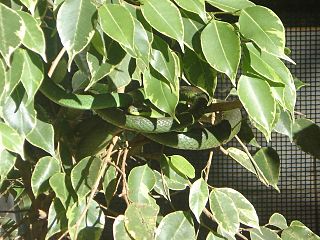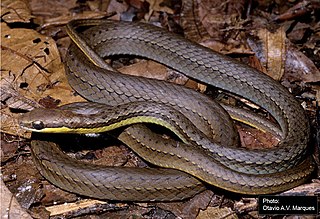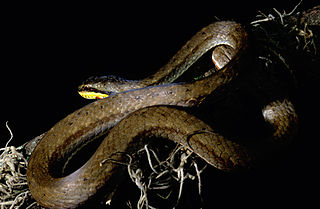
Chironius is a genus of New World colubrid snakes, commonly called sipos, savanes, or sometimes vine snakes. There are 23 described species in this genus.

Oxybelis fulgidus, commonly known as the green vine snake or the flatbread snake, is a species of long, slender, arboreal colubrid snake, which is endemic to Central America and northern South America.
Dixon's ground snake is a species of snake in the family Colubridae. The species is endemic to Southeastern Brazil.
Liotyphlops schubarti is a species of snake in the family Anomalepididae. The species is endemic to Brazil.

Liotyphlops wilderi, also known as Wilder's blind snake, is a species of snake in the family Anomalepididae. The species is endemic to Brazil.
The Espírito Santo blind snake is a species of snake in the family Leptotyphlopidae. The species is endemic to Brazil.

The Brazilian coral snake is a species of coral snake in the family Elapidae.

Chironius laurenti is a species of nonvenomous snake in the family Colubridae. The species is endemic to Bolivia and Brazil. The species was named in honor of Raymond Laurent.
Coronelaps is a genus of snake in the family Colubridae that contains the sole species Coronelaps lepidus. It is also known as the Minas Gerais snake or crowned burrowing snake.

The Brazilian burrowing snake is a snake endemic to Brazil. It is monotypic in the genus Gomesophis.
The fanged water snake is a genus of snake in the family Colubridae.

Dryophylax almae is a species of snake in the family Colubridae. The species is endemic to Brazil.

Atractus pantostictus is a species of snake in the family Colubridae.
Apostolepis gaboi, also known commonly as the sand dunes blackhead and the cobra-rainha das dunas in Brazilian Portuguese, is a species of snake in the family Colubridae. The species is endemic to Brazil.
Atractus francoi, also known commonly as cobra-da-terra in Brazilian Portuguese, is a species of snake in the family Colubridae. The species is endemic to Brazil.

Echinanthera cephalostriata is a species of snake of the family Colubridae in the subfamily Dipsadinae. The species is endemic to Brazil. Echinanthera cephalostriata is a species in the family Colubridae, common name "Head-striped Leaf-litter Snake". They're a slender, small to medium length snake, with a blotched pattern along their back and a thick black stripe down the sides. They're usually seen in colors of brown and grey, and have a bright yellow venter, with characteristically big eyes and a small head. They're non-venomous, and prey mainly upon amphibians. They are diurnal and might be spotted near creeks. They range from the Brazilian states of Santa Catarina, Paraná, São Paulo, Gerais, Rio de Janeiro, and Espírito Santo. Little information has been recorded on this species.

Mesotes rutilus, Prado's coastal house snake, is a species of snake in the family Colubridae. The species is native to Brazil.
Philodryas arnaldoi, Arnaldo's green racer, is a species of snake of the family Colubridae.

Chironius bicarinatus, the two-headed sipo, is a species of snake in the family Colubridae. The species is found in Brazil, Argentina, Uruguay, and Paraguay.
Chironius laevicollis, the Brazilian sipo, is a species of colubrid snake from Brazil. This species is endemic to the Atlantic Forest along the country's southeast coast, and is common and widespread throughout its range.











